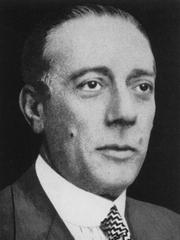|
Enrique Finochietto, MD (1881 – 1948) Argentinian surgeon and researcher, Enrique Finochietto was born in 1881 in the city of Buenos Aires. He studied in both public and private schools, entering medical school at age 16. He received his medical degree from the University of Buenos Aires in 1904.
Shortly after graduation, he became an intern at the Rawson hospital of Buenos Aires. Dr. Finochietto would become part of the staff of this hospital and be part of its staff all his life. He traveled to Europe to study with surgeons such as Calot, Kocher, Roux, and others, visiting France, Switzerland, Austria, and Italy.
Upon his return he dedicated himself to surgery and endoscopy, and with the help of his brother Ricardo started research and invented many medical and surgical devices, including a motorized surgical table, endoscopic devices and surgical instruments, some of which are in use today throughout the world.
|
|
| During World War I Dr. Finochietto worked for no fee (ad honorem) as surgeon-in-chief at the Argentine Hospital in Paris. For his dedication and work, France awarded him the Legion d’Honneur and the Red Cross. He came back to Argentina and then traveled to the USA where he visited with the Mayo Brothers and Harvey Cushing. One of Dr. Finochietto’s mottos was “Only the surgeon who goes beyond his obligations serves his duty”.
Although mostly remembered for the Finochietto rib spreader, Dr. Finochietto tackled most types of surgery during his career, including neurosurgery, gastrointestinal, thyroid, thoracic, and orthopedic.
Dr. Finochietto died on February 17, 1948. His legacy in Argentinian surgery lives on through his school of thought, research and disciples.
If you click on Dr. Finochietto’s image (courtesy of Wikipedia) you will see an image of his namesake rib spreader (courtesy of Surgiway, France ).
Sources:
1. “Memoir: Enrique Finochietto, MD (1881 – 1948)” DeBakey. ME. Ann Surg. 1948 Aug; 128(2): 319–320
2. “Enrique Finochietto” The Legacy of Surgery in Argentina” De La Fuente, SG. J Surg Ed (2007)64:2; 120-123
3. “El separador intercostal de Enrique Finochietto, el hospital Rawson, la escuela quir?rgica, y una an?cdota que los relaciona” Saadia, A. Rev Arg Cir Cardiovasc (2009) 3:3 149-150
4. “Rese?as hist?ricas: Enrique Finochietto” Parquet RA. Acta Gastroenterol Latinoam (2009); 39:18
5. “Surgery in Argentina” Beveraggi, EM. Arch Surg (1999) 134”438-444
6. “The Legends Behind Cardiothoracic Surgical Instruments” Ailawadi, G et al. Ann Thorac Surg (2010) 89:5; 1693-1700
|



